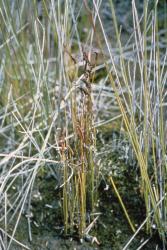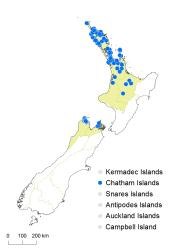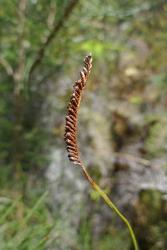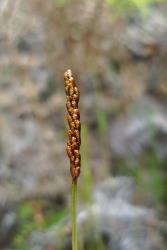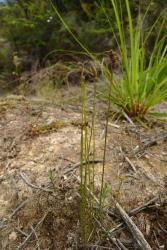- ≡ Acrostichum fistulosum (Labill.) Poir., Encyc. Suppl. 1, 125 (1810)
- ≡ Microschizaea fistulosa (Labill.) C.F.Reed, Bol. Soc. Brot. Ser. 2 21: 134 (1948)
- = Schizaea propinqua A.Cunn., Companion Bot. Mag. 2: 362 (1837)
- ≡ Schizaea fistulosa var. propinqua (A.Cunn.) Bonap., Notes ptérid. 13, 289 (1921)
Rhizomes short-creeping; bearing glossy, chestnut-brown, septate hairs, 1.5–3.5 mm long. Fronds 115–570 mm long, 2–5 mm wide. Sterile portion of frond undivided, erect, 100–550 mm long, ±terete, furrowed on one side, 0.5–1.0 mm in diameter, green or pale brown, glabrous or with scattered hairs; stomata on sterile portion of frond 126–180 μm long. Fertile portion of frond pinnately divided, 9–30 mm long, rarely to 38 mm long, 2–5 mm wide; ultimate branches infolded, in 7–30 pairs, 2–5 mm long, with fimbriate margins. Sporangia borne in one row either side of midrib of ultimate fertile branches, 5–12 per branch; hairs absent amongst sporangia.
Schizaea fistulosa is closely related to S. australis but differs in its longer fronds (115–570 mm cf. 20–350 mm long), longer fertile portions of the frond (9–38 mm cf. 3–17 mm long), more pairs of fertile branches (7–30 cf. 4–13 pairs), its generally lowland and more northerly distribution, and its habit of producing relatively robust, straight, tall fronds, often amongst other vegetation. The distributions of the two species overlap on Great Barrier Island, Mt Moehau, and in north-west Nelson, but only in north-west Nelson are populations frequently found in the same altitudinal range. S. fistulosa is distinct from S. australis in having twice as many chromosomes (n = c.190 cf. n = 94). This ploidy difference is reflected in the size of the guard cells of the stomata, which are arranged in long vertical lines on the sterile laminal segments and visible under a dissecting microscope. The guard cells are 126–180 μm long in S. fistulosa compared with 81–114 μm long in S. australis (Brownsey & Perrie 2013).
North Island: Northland, Auckland, Volcanic Plateau, Taranaki.
South Island: Western Nelson, Sounds Nelson.
Chatham Islands.
Altitudinal range: 0–700 m.
Schizaea fistulosa occurs throughout Northland and Auckland, in the King Country, around Rotorua, on heated ground at Tokaanu, in a few localities in northern South Island from Whanganui Inlet to Croisilles Harbour, and on the Chatham Islands. In the North Island it extends from sea level to about 360 m on Great Barrier Island and 700 m on Mt Moehau. In the South Island it is confined to lowland sites.
Also Peninsular Malaysia, Borneo, New Guinea, Australia (Western Australia, South Australia, NSW, Victoria, Tasmania), New Caledonia, Fiji, Society Islands, Marquesas Islands.
A terrestrial fern that grows in lowland areas on gumland and poor clay or sandy soils, pākihi, or sometimes on hummocks in Sphagnum bog, either in the open, under light mānuka, kānuka or Hakea scrub, or in open kauri forest. It sometimes grows in moss cushions under scrub, and on heated ground in the Rotorua/Taupō region.
There is some cytological evidence for hybridisation between S. australis and S. fistulosa (Brownsey et al. 1985). Lash (1966) reported n = 94 for several populations of S. australis from north-west Nelson, and n = c.150 for other populations from the same area with generally larger plants. Reinterpretation of Lash’s illustrated cell suggested the presence of at least some univalents (Brownsey et al. 1985), and the possibility of hybridisation causing failure of pairing. Lash’s count of c.150 is consistent with hybridisation between S. fistulosa and S. australis in north-west Nelson where both species are known to occur.
n = c.190 (Brownsey et al. 1985; Dawson et al. 2000); n = c.270 (Brownlie 1965). The latter count may have been an erroneous count from a tapetal cell (see Brownsey et al. 1985).



